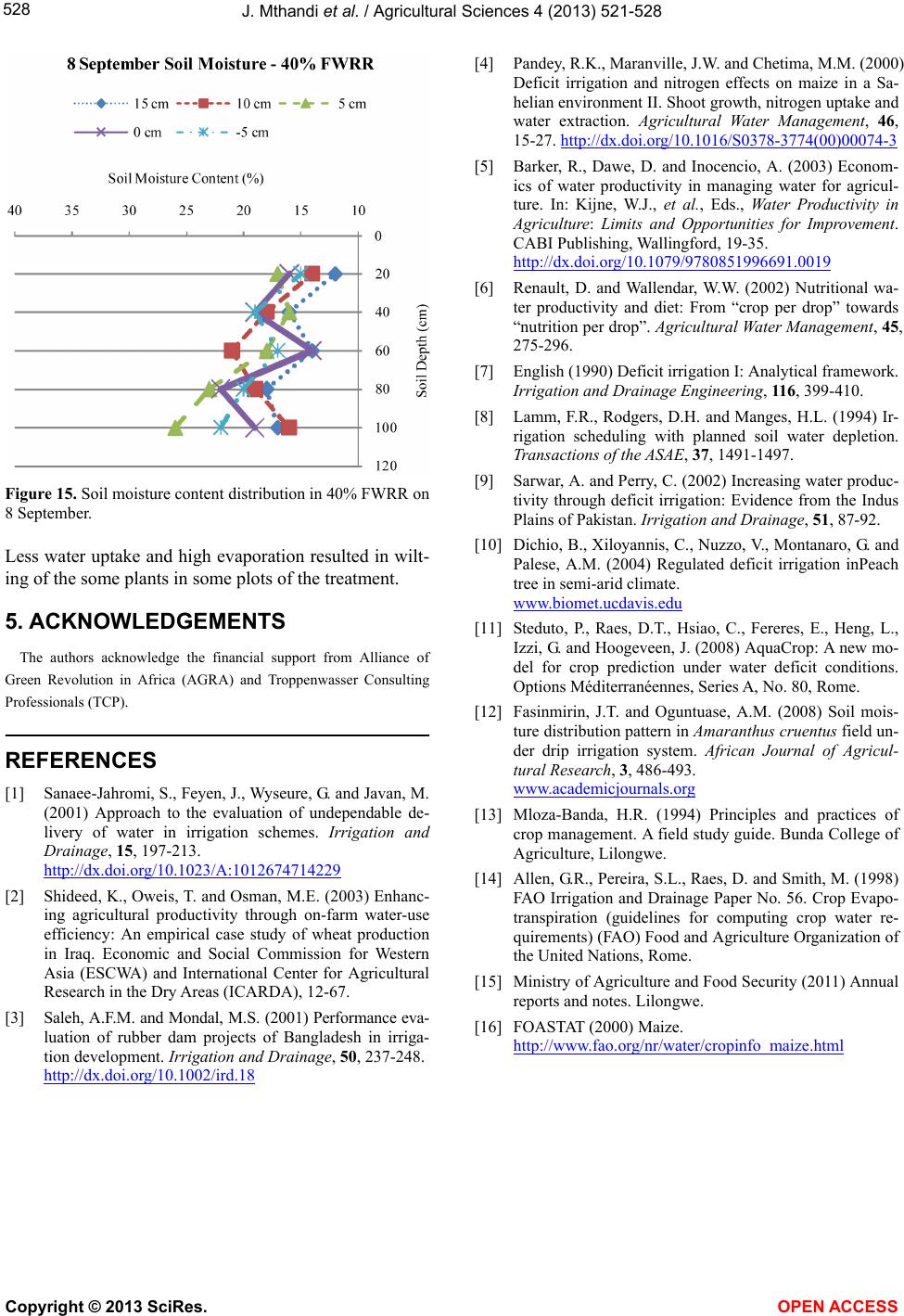
J. Mthandi et al. / Agricultural Sciences 4 (2013) 52 1-528
Copyright © 2013 SciRes.
528
[4] Pandey, R.K., Maranville, J.W. and Chetima, M.M. (2000)
Deficit irrigation and nitrogen effects on maize in a Sa-
helian environment II. Shoot growth, nitrogen uptake and
water extraction. Agricultural Water Management, 46,
15-27. http://dx.doi.org/10.1016/S0378-3774(00)00074-3
[5] Barker, R., Dawe, D. and Inocencio, A. (2003) Econom-
ics of water productivity in managing water for agricul-
ture. In: Kijne, W.J., et al., Eds., Water Productivity in
Agriculture: Limits and Opportunities for Improvement.
CABI Publishing, Wallingford, 19-35.
http://dx.doi.org/10.1079/9780851996691.0019
[6] Renault, D. and Wallendar, W.W. (2002) Nutritional wa-
ter productivity and diet: From “crop per drop” towards
“nutrition per drop”. Agricultural Water Management, 45,
275-296.
[7] English (1990) Deficit irrigation I: Analytical framework.
Irrigation and Drainage Engineering, 116, 399-410.
[8] Lamm, F.R., Rodgers, D.H. and Manges, H.L. (1994) Ir-
rigation scheduling with planned soil water depletion.
Transactions of the ASAE, 37, 1491-1497.
[9] Sarwar, A. and Perry, C. (2002) Increasing water produc-
tivity through deficit irrigation: Evidence from the Indus
Plains of Pakistan. Irrigation and Drainage, 51, 87-92.
Figure 15. Soil moisture content distribution in 40% FWRR on
8 September.
[10] Dichio, B., Xiloyannis, C., Nuzzo, V., Montanaro, G. and
Palese, A.M. (2004) Regulated deficit irrigation inPeach
tree in semi-arid climate.
www.biomet.ucdavis.edu
Less water uptake and high evaporation resulted in wilt-
ing of the some plants in some plots of the treatment.
5. ACKNOWLEDGEMENTS [11] Steduto, P., Raes, D.T., Hsiao, C., Fereres, E., Heng, L.,
Izzi, G. and Hoogeveen, J. (2008) AquaCrop: A new mo-
del for crop prediction under water deficit conditions.
Options Méditerranéennes, Series A, No. 80, Rome.
The authors acknowledge the financial support from Alliance of
Green Revolution in Africa (AGRA) and Troppenwasser Consulting
Professionals (TCP). [12] Fasinmirin, J.T. and Oguntuase, A.M. (2008) Soil mois-
ture distribution pattern in Amaranthus cruentus field un-
der drip irrigation system. African Journal of Agricul-
tural Research, 3, 486-493.
www.academicjournals.org
REFERENCES
[1] Sanaee-Jahromi, S., Feyen, J., Wyseure, G. and Javan, M.
(2001) Approach to the evaluation of undependable de-
livery of water in irrigation schemes. Irrigation and
Drainage, 15, 197-213.
http://dx.doi.org/10.1023/A:1012674714229
[13] Mloza-Banda, H.R. (1994) Principles and practices of
crop management. A field study guide. Bunda College of
Agriculture, Lilongwe.
[14] Allen, G.R., Pereira, S.L., Raes, D. and Smith, M. (1998)
FAO Irrigation and Drainage Paper No. 56. Crop Evapo-
transpiration (guidelines for computing crop water re-
quirements) (FAO) Food and Agriculture Organization of
the United Nations, Rome.
[2] Shideed, K., Oweis, T. and Osman, M.E. (2003) Enhanc-
ing agricultural productivity through on-farm water-use
efficiency: An empirical case study of wheat production
in Iraq. Economic and Social Commission for Western
Asia (ESCWA) and International Center for Agricultural
Research in the Dry Areas (ICARDA), 12-67. [15] Ministry of Agriculture and Food Security (2011) Annual
reports and notes. Lilongwe.
[3] Saleh, A.F.M. and Mondal, M.S. (2001) Performance eva-
luation of rubber dam projects of Bangladesh in irriga-
tion development. Irrigation and Drainage, 50, 237-248.
http://dx.doi.org/10.1002/ird.18
[16] FOASTAT (2000) Maize.
http://www.fao.org/nr/water/cropinfo_maize.html
OPEN A CCESS